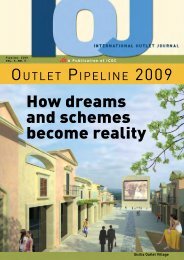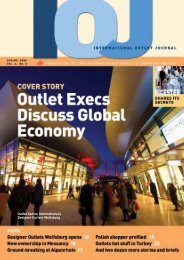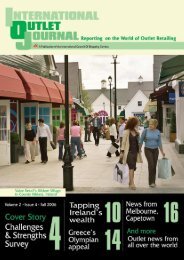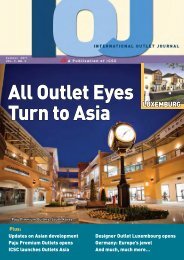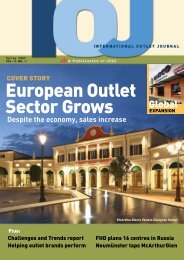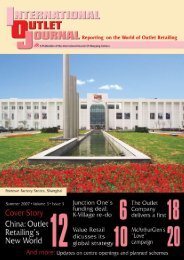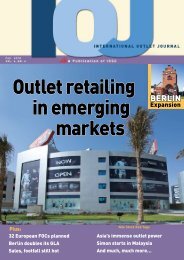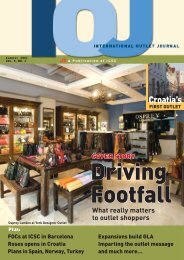For Designer Style, It's All Outlet - Value Retail News
For Designer Style, It's All Outlet - Value Retail News
For Designer Style, It's All Outlet - Value Retail News
Create successful ePaper yourself
Turn your PDF publications into a flip-book with our unique Google optimized e-Paper software.
iCSC OuTlETS aSia<br />
(continued from page 27)<br />
going didn’t materialize. “Then comes<br />
the global financial crisis and the opportunity<br />
was lost,” Hamilton said.<br />
“I mention this because this was an<br />
extremely prime site. But the partnership<br />
was not able to work and the opportunity<br />
was lost – so no matter how good the<br />
site is, if you can’t make the partnership<br />
work, the real estate opportunity you<br />
think you have is really not there.”<br />
Choosing the right partner in China<br />
requires ensuring each side’s interests<br />
align in every way possible, Hamilton<br />
said. And where they don’t align, success<br />
requires a deep understanding of each<br />
partner’s differences, whether it’s the<br />
pace of each other’s decision-making,<br />
their different cost of capital, income<br />
streams, perspectives on risk, everything.<br />
2 views of domestic brands:<br />
Keep them in?<br />
Or kick them out?<br />
EWB’s James Rickson said Chinese<br />
outlets centers should lose their domestic<br />
brands because they spoiled the fun and<br />
festive feel of the shopping experience.<br />
“In China, when I look at outlets, the<br />
mixing of local brands and international<br />
brands dilutes that<br />
experience,” he<br />
said. “Visitors see<br />
several stores that<br />
meet their expectations<br />
and then they<br />
see several stores<br />
they can drive to<br />
James Rickson<br />
down the street.”<br />
The point<br />
reminded him of a slide that Rockvale’s<br />
David Ober showed at an earlier<br />
conference session. Citing recent surveys,<br />
it showed that only 10 percent of<br />
outlet shoppers made repeat visits to<br />
the same center.<br />
“We need shoppers to come back time<br />
and time again. The industry can’t survive<br />
on a 10-percent return. We need 25, 40,<br />
50, 100 percent, hopefully,” Rickson said.<br />
“In China, we still haven’t seen an outlet<br />
mall with 100-percent international brands<br />
to give the customer that same experience<br />
she gets in Europe or the United States.”<br />
The presence of so many domestic<br />
tenants in China’s outlet centers,<br />
Rickson suggested, means international<br />
brands would be reluctant to support<br />
center marketing campaigns to attract<br />
shoppers from outside the local area.<br />
28 InternAtIOnAl <strong>Outlet</strong> JOurnAl Fall 2011<br />
“In China, the mixing<br />
of local brands<br />
and international<br />
brands dilutes that<br />
outlet experience.”<br />
James rickson, eWB<br />
In the conference’s closing session,<br />
Chris Milliken, commercial director of<br />
UK-based Freeport, offered a lengthy<br />
rebuttal.<br />
“Look,” he said. “We have our own<br />
domestic brands in Europe and I’m<br />
happy to have them. Don’t forget, the<br />
uniqueness is in the price point – you’re<br />
getting 30 to 50 to 70 percent off.<br />
“We should pay more attention to<br />
domestic brands<br />
in this market,”<br />
he said. “They<br />
kind of got a bad<br />
name in China,<br />
partly because<br />
outlets tend to<br />
hide them around<br />
the back – they’re<br />
all put together<br />
Chris Milliken<br />
like a second division and they don’t<br />
get the footfall so they’re bound to<br />
spiral downward. If we took them<br />
“We should pay more<br />
attention to domestic<br />
brands in this<br />
market… If we took<br />
them more seriously,<br />
helped them with<br />
their merchandising,<br />
helped them fit out<br />
correctly and helped<br />
them with signage,<br />
you’ll fill your center<br />
and help it perform<br />
better.”<br />
Chris Milliken, Freeport<br />
more seriously, helped them with<br />
their merchandising, helped them fit<br />
out correctly and helped them with<br />
signage, you’ll fill your center and help<br />
it perform better.”<br />
The Freeport executive sees domestic<br />
and mass market brands as an<br />
important part of the overall outlet<br />
mix. “People will buy luxury but they<br />
accessorize with other things,” he said.<br />
“A lady may buy an Armani coat for<br />
$1,000 but then she might equally go<br />
to H&M to buy a shirt for $35,” he<br />
said. Consumers don’t buy only luxury,<br />
he said. They buy a mix of things,<br />
which means that domestic brands are<br />
becoming become more important.<br />
Milliken said he had recently surveyed<br />
the 10 billboards in the arrivals hall of<br />
Beijing Airport’s massive Terminal 3<br />
and noticed that all but one advertised<br />
domestic brands. The lone exception<br />
was Gucci – which “doesn’t do outlets<br />
in China,” Milliken pointed out.<br />
Chinese millionaires<br />
At an earlier conference session,<br />
Shanghai-based KPMG partner Tracy<br />
Yang walked attendees through the latest<br />
luxury data. China’s luxury market grew<br />
to ¥80 billion (€8.6 billion) in 2010 from<br />
¥55 billion (€3 billion) in 2008 and is<br />
projected to grow 18 percent annually to<br />
¥180 billion (€19.4<br />
billion) at current<br />
exchange rates by<br />
2015.<br />
Yang also offered<br />
some demographic<br />
snapshots from<br />
KPMG: 960,000<br />
Chinese have<br />
individual worth of<br />
Tracy yang<br />
more than ¥10 million (€1 million) and<br />
60,000 Chinse have individual worth of<br />
¥100 million (€150 million).<br />
China’s millionaires, she said, tend<br />
to be younger and more free-spending<br />
than their Western counterparts. They<br />
are found everywhere in China but<br />
remain heavily concentrated in wealthy<br />
coastal centers.<br />
The wealthy account for the vast bulk<br />
of luxury consumption, she said, but<br />
China’s emerging middle class is becoming<br />
aspirational, accounting for 13 percent of<br />
luxury sales in 2010, according to Yang.<br />
The data explains why more of the<br />
world’s top luxury brands are focusing<br />
on China. But Freeport’s Milliken of-





